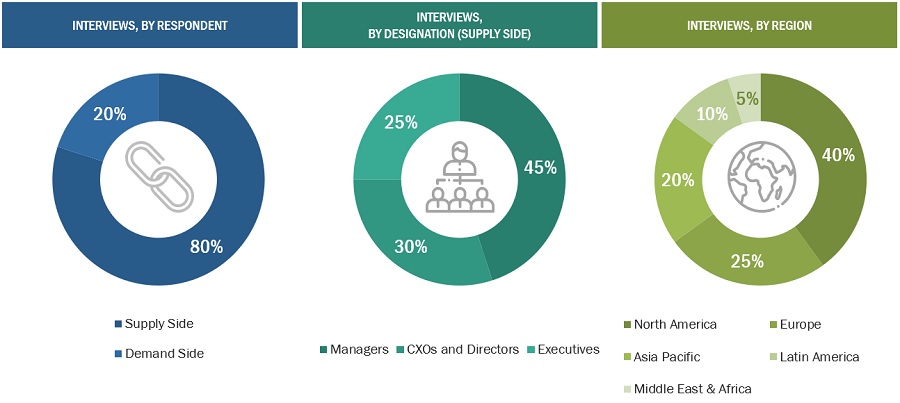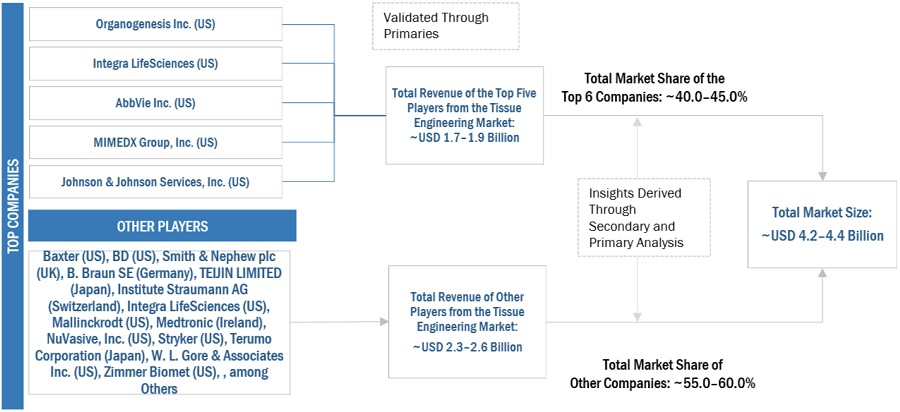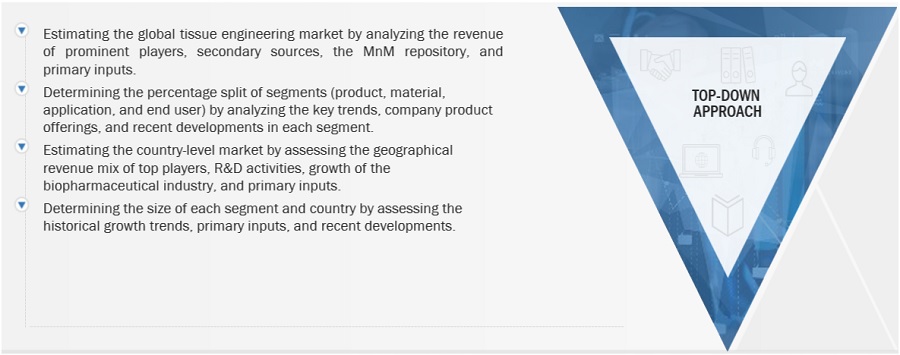This research study involved the extensive use of secondary sources, directories, and databases to identify and collect valuable information for the analysis of the global tissue engineering market. In-depth interviews were conducted with various primary respondents, including key industry participants, subject-matter experts (SMEs), C-level executives of key market players, and industry consultants, to obtain and verify critical qualitative and quantitative information and assess the growth prospects of the market. The global market size estimated through secondary research was then triangulated with inputs from primary research to arrive at the final market size.
Secondary Research
Secondary research was used mainly to identify and collect information for the extensive, technical, market-oriented, and commercial study of the tissue engineering market. The secondary sources used for this study include the National Institute of Environmental Health Sciences (NIH), US Food and Drug Administration (FDA), the Center for Disease Control and Prevention (CDC), Organ Procurement & Transplantation Network (OPTN), the U.S. Department of Health & Human Services, Mayo Foundation for Medical Education and Research (MFMER), Commonwealth of Australia Department of Health and Aged Care, International Organization for Standardization (ISO), Stemaid Institute Baja California, Alzheimer’s Association, Statista, annual reports, press releases, investor presentations, and among others. These sources were also used to obtain key information about major players, market classification, and segmentation according to industry trends, regional/country-level markets, market developments, and technology perspectives.
Primary Research
Extensive primary research was conducted after acquiring basic knowledge about the global tissue engineering market scenario through secondary research. Several primary interviews were conducted with market experts from the demand side, such as ambulatory surgical centers, hospitals, specialty clinics, and transplant centers, and experts from the supply side, such as C-level and D-level executives, product managers, marketing & sales managers of key manufacturers, distributors, and channel partners. These interviews were conducted across five major regions, including the Asia Pacific, North America, Europe, Latin America, and the Middle East & Africa. Approximately 80% and 20% of the primary interviews were conducted with supply-side and demand-side participants, respectively. This primary data was collected through questionnaires, e-mails, online surveys, personal interviews, and telephonic interviews.
The following is a breakdown of the primary respondents:

To know about the assumptions considered for the study, download the pdf brochure
Market Size Estimation
Both top-down and bottom-up approaches were used to estimate and validate the total size of the tissue engineering market. These methods were also used extensively to estimate the size of various subsegments in the market. The research methodology used to estimate the market size includes the following:
Bottom-up Approach
-
The key players in the industry and market have been identified through extensive secondary research.
-
The revenues generated from the tissue engineering business of leading players have been determined through primary and secondary research.
-
All percentage shares, splits, and breakdowns have been determined using secondary sources and verified through primary sources.

To know about the assumptions considered for the study, Request for Free Sample Report
Top-down Approach
After arriving at the overall market size from the market size estimation process, the total market was split into several segments and subsegments.

Data Triangulation
To complete the overall market engineering process and arrive at the exact statistics for all segments and subsegments, data triangulation and market breakdown procedures were employed, wherever applicable. The data was triangulated by studying various factors and trends from both the demand and supply sides.
Market Definition
Tissue engineering is a multidisciplinary field that combines various principles from life sciences and engineering to develop functional biological tissues for medical applications. The goal of tissue engineering is to assemble functional constructs that restore, maintain, or improve damaged tissues or whole organs. The scope of the report includes FDA-approved tissue-engineered products that contain engineered human cells or tissues and have properties for the regeneration, repair, or replacement of tissue where the new tissue or cells are intended to restore or improve the function of the recipient’s/patient’s organ or tissue.
Stakeholders
-
Pharmaceutical & Biopharmaceutical Companies
-
Biotechnology Companies
-
Healthcare Service Providers (Including Hospitals and Ambulatory Care Service Providers)
-
Contract Development and Manufacturing Organizations
-
Market Research & Consulting Firms
-
Venture Capitalists & Investors
-
Government Associations
-
Academic & Research Institutes
Report Objectives
-
To define, describe, and forecast the global tissue engineering market based on application, material, product type, end user, and region.
-
To provide detailed information regarding the major factors influencing the growth of the market (such as drivers, restraints, opportunities, and challenges)
-
To strategically analyze micro-markets with respect to individual growth trends, future prospects, and contributions to the overall tissue engineering market
-
To analyze opportunities in the market for stakeholders and provide details of the competitive landscape for market leaders.
-
To forecast the size of the market segments with respect to five main regions, namely, North America, Europe, Asia Pacific, Latin America, and the Middle East and Africa
-
To strategically profile the key players and comprehensively analyze their product portfolios, market positions, and core competencies.
-
To track and analyze competitive developments such as acquisitions, agreements, collaborations, product launches, expansions, and R&D activities in the tissue engineering market.
Available Customizations
With the given market data, MarketsandMarkets offers customizations as per the company’s specific needs. The following customization options are available for this report:
Segment Analysis
-
Further breakdown of the other applications segments as per the product applications.
-
Further breakdown of the other products as per the product portfolio of prominent players operating in the market.
Company Information
-
Detailed analysis and profiling of additional market players (up to five).
Geographical Analysis
-
Further breakdown of the Rest of European tissue engineering market into countries
-
Further breakdown of the Rest of Asia Pacific tissue engineering market into countries
-
Further breakdown of the Rest of Latin American tissue engineering market into countries



Growth opportunities and latent adjacency in Tissue Engineering Market